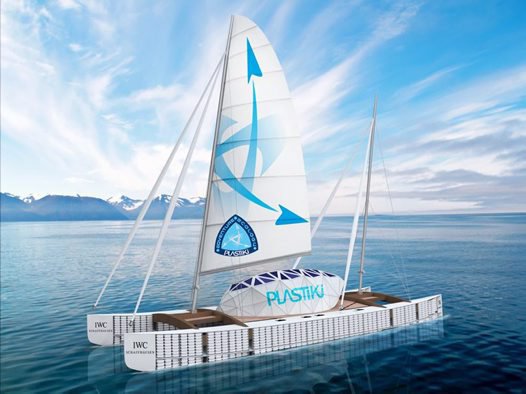Plastiki – A solution to waste
One man's environmental dream becomes a reality and he is educating the planet to consider waste as a resource. The Plastiki is history in the making! I would like to share something I find really inspiring and the reason I find this inspiring is that a problem is highlighted and a solution is offered.

© Australian Museum
The answer to climate change and other environmental issues is finding different ways of doing things through system changes.
We are living is an era of environmental madness where we are continuing to do the same thing over and over again and getting the same crazy destructive result. Our planet cannot sustain this and it is time for change.
So what if I told you that it is possible to build a 20 metre catamaran made from reclaimed plastic bottles, self reinforced P.E.T and recycled waste products. Would you believe me?
Well it is possible and it has just finished being built and in a matter of weeks it will set sail from San Francisco via the Pacific Ocean and the expedition will finish here in Sydney.
This amazing vessel is called Plastiki and it is a symbol of what is possible and what is necessary. Its mission is to educate as many people as possible on how to beat waste and re-think waste as a resource.
We all know that waste contributes to climate change and I have previously blogged about waste in our oceans, the Great Pacific Garbage Patch and plastic bottles. The most important fact about waste is when we throw things away there is no “away”. All the waste goes somewhere and in the not too distant future “away” will be full. Then what?
Plastiki will venture past the Great Pacific Garbage patch on its journey to Australia. Plastiki will also be stopping off at Pacific islands along the way and the crew will be learning and highlighting environmental issues facing each of them.
How did Plastiki come to be? An environmental adventurer by the name of David de Rothschild read a 2006 UNEP report that said “that there is an average of forty six thousand pieces of plastic debris floating on or near the surface of every square mile of ocean”
David’s reaction to this information was the same as anyone’s that read the report BUT it is David’s re-action to this knowledge that is unique and inspiring.
David came up with the idea of using plastic bottles to build the Plastiki to show how we can beat waste by reusing it.
I admire David for what he is trying to achieve, he is thinking about the future (my future and the planets) and through adventure will hopefully inspire action to reduce, reuse and recycle more of our natural resources.
It has taken David a few years to get to this point. David has a great team around him and the skipper for this adventure is Jo Royle who is an experienced ocean sailor and she too cares about waste and the affect it is having on our planet.
Plastiki was designed based on “cradle to cradle’ principles and biomimicry. “Cradle to Cradle” is the idea that at the end of life, any product can be turned into something else close to the cycle so that ultimately there is no waste. Biomimicry is innovation inspired by nature and looking to nature for solutions.

© Australian Museum
The Plastiki Expedition is about:
Explaining how waste is a design flaw.
It is about getting us to understand about the materials used in our everyday lives and question where they come from, what is it actually made from and will it harm us or the planet and how can we reuse it when we have finished with it. When you have a look around you nearly everything is made of plastic and maybe we need to be asking ourselves is it necessary.
It is about rethinking and just because we have always done it this way we need to ask the question is there a better, safer way.
It is about getting the world to work together, from our world leaders down to us.
Change takes time and sometimes we have to unlearn things and relearn a better way to have a better outcome.
At the end of her journey Plastiki will be dismantled and up-cycled.
To find out more about Plastiki go the website: www.theplastiki.com
I had a moment like David’s when he read the UN report. I was in Paris in 2008. I was visiting the Louvre Museum and I was walking along the fountain walls and saw lots and lots of plastic bottles in the drain of the beautiful fountain. I could not believe how many there were and I thought to myself this is not right but what can I do about it and why doesn’t anyone care? Why do we need the single use plastic water bottle? Why do people think it is ok to just throw these bottles anywhere?
I wish David, Jo and the team a safe, fun and learning adventure and look forward to greeting them when they arrive in our beautiful harbour in a few months time.
The only problem the crew may encounter as they enter our waters is that they may have to fight off a small female pirate trying to hitch a ride – arghhh –death to the plastic bottle!
I believe we need a future that doesn’t have limits, pollution and so much waste.
Wouldn’t it be great to create and design things that didn’t harm the environment but was actually good for it?
Remember “Habits made today will help life tomorrow.”

